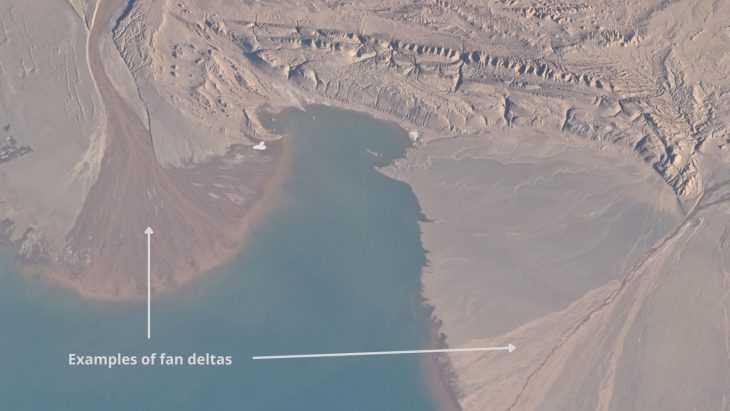[ad_1]
One picture from the surface of Mars can tell us an entire story about the history and formation of that place. Often, the similarities and differences observed between Earth and Mars help us better understand our own planet and potentially, the terrain of an extraterrestrial planet future humans may walk on. In the case of NASA’s Mars 2020 Perseverance rover science team, a picture is truly worth 1000 words. An international group of scientists have presented the first scientific analysis of images from Jezero Crater, Mars.
The images tell a story of a quiet crater lake fed by a small river for most of its existence 3.7 billion years ago. Near the end of the lake’s life, several powerful flash floods swept down the crater walls. The water moved meter-sized boulders at speeds of 4-19 mph from 40+ miles upstream to their current location in what is now a dried-up lake bed. To get a sense of how powerful these flash floods were, one can imagine a river pushing a compact car from San Francisco to San Jose, CA, in two hours!
The authors propose that these flood episodes could have formed through intense rainfall, rapid snowmelt from either climate change or volcanoes, or through the building and melting of glaciers. To find the footprints of these events, they used satellite and rover images to get a better look at the rocks within and around the crater. This will teach them about what kinds of processes may have occurred on Mars when it still had water on it.
Using two cameras aboard the Perseverance rover (Mastcam-Z and the SuperCam Remote Micro-Imager) the researchers saw rocks protruding from the mouth of a river inside the Jezero Crater. The satellite images showed that the rock protrusions were on the wide edge of the river’s fan-shaped mouth, called a “delta.” Knowing the exact location of these protrusions, called outcrops, helped the scientists better describe the surface. The satellite images also revealed a desert landscape with boulders and outcrops.

Image of fan deltas in China and Tibet, taken from the International Space Station. Labeling added by Sciworthy. Source: Flickr
One such isolated flat-topped outcrop was dubbed the Kodiak butte. The scientists could see from the images that the rock was layered. The “stripes” of those layers tilted at various angles and were accompanied by rounded rocks of different sizes. The tilt angle and thickness of the layers and the shape and size of embedded rocks can tell scientists what geologic process deposited the material. These processes can be flowing river water, wind deposition, sheet-like floods, or accumulation at a lake or ocean bottom. This tells us more about the history of Mars.

The image on the left shows even layers from calm conditions. More tilts (on the right) means more dramatic events happened here.
If a lake was responsible for the gradual accumulation of rock, you’d expect to see the rock layers running mostly horizontally. Alternatively, rock deposits made by turbulent water – rivers or waves – will be more tilted. The thickness of any type of rock layer, whether horizontal or tilted, will tell you how long it has been there relative to what is nearby. So, that means scientists can tell just by looking at the rocks whether a river carved out a lake over time or if waves suddenly changed part of a rock formation.
They observed a lot of round rocks scattered amongst fine sediments, which indicates that there was probably a lot of river activity here. The tumbling action of the water will have smoothed the edges. The bigger the rocks, the more water power needed to move them. In fact, some of these were large boulders estimated to weigh as much as a car! Due to their size, they could have only been transported here from outside the crater rim through high-energy flash floods. This provided an excellent opportunity to analyze rocks from outside of Jezero Crater without traveling further. The finer, lighter sediments likely settled at the bottom of the lake during periods of gently flowing water.

An example of smooth cobbles embedded in rock sediment. This is evidence of rocks carried by flowing water over time. (Picture taken from Hazeva Formation (Miocene) of southern Israel) Source
In an instance of similar geology between Earth and Mars, the rock beds on Kodiak butte corresponded in thickness, tilt, and sequence of events to a type of delta found on Earth that is associated with water flow into a lake. These are called “Gilbert-type” deltas. Similarly-tilted beds were found along the western fan outcrops, confirming that the entire area was an ancient delta feeding into a crater lake. Alternating tilted and horizontal layers implied on and off periods of flash flooding and fluctuating lake levels.
By carefully analyzing every pixel from the rover and satellite Mars images, the researchers built a snippet of Jezero Crater’s history – a place so different yet so similar to our own planet Earth.
[ad_2]
Source link





